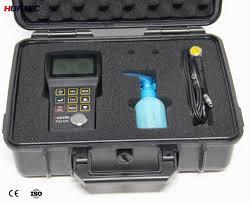Coating quality is a critical parameter in many industries, ranging from automotive to aerospace and marine applications. A thru-coat thickness gauge plays an essential role in ensuring that coatings meet the required specifications. This article provides an in-depth look at what a thru-coat thickness gauge is, how it functions, its benefits, and the factors to consider when selecting and maintaining this important piece of equipment.
Understanding Thru-Coat Thickness Gauges
A thru-coat thickness gauge is a specialized instrument designed to measure the thickness of a coating without the need to remove it from the substrate. Unlike conventional gauges that might require sample preparation or destructive testing, a thru-coat gauge offers a non-invasive method for assessing coating thickness directly on the finished product. This capability is particularly useful in quality control processes where maintaining the integrity of the coating is essential.
In many industrial applications, the accuracy of a coating is paramount. Whether it is a protective layer on steel or a decorative finish on an automobile, even minor deviations in thickness can lead to reduced performance or premature failure. A thru-coat thickness gauge helps ensure that coatings adhere to the specified standards, thereby guaranteeing durability and performance.
How Thru-Coat Thickness Gauges Work
Thru-coat thickness gauges operate on several principles, with the most common methods being magnetic induction and eddy current technology. These technologies allow the device to measure the distance between the coating’s outer surface and the underlying substrate.
Magnetic induction gauges are particularly effective for non-magnetic coatings on ferrous substrates. They work by generating a magnetic field and detecting changes in the field’s strength as it passes through the coating. The eddy current method, on the other hand, is used primarily for non-conductive coatings on conductive substrates. This technique induces circulating currents within the substrate, and the resulting changes in these currents are used to determine the coating’s thickness.
Advances in sensor technology and digital signal processing have significantly enhanced the accuracy and ease of use of these gauges. Modern devices often feature digital displays, data logging capabilities, and connectivity options for integration with quality management systems. As a result, operators can quickly and reliably obtain measurements, ensuring that each coating meets the precise specifications required for its application.
Key Features and Benefits
One of the standout benefits of using a thru-coat thickness gauge is its non-destructive testing method. Since the device measures the coating without damaging it, manufacturers can conduct frequent inspections without compromising the product. This aspect is particularly valuable during the production process, where continuous monitoring can help identify potential issues before they escalate into costly defects.
Precision is another key feature. With advanced calibration and sensor technology, modern gauges can detect even slight variations in coating thickness. This level of sensitivity is critical in high-performance applications, where even minimal deviations can affect the overall quality and functionality of the coated product.
Ease of use is also a major advantage. Many gauges are designed with ergonomic features and intuitive interfaces that minimize the learning curve for operators. The ability to perform quick, reliable measurements helps streamline the quality control process and reduces the risk of human error.
Additionally, the durability and rugged design of many thru-coat thickness gauges make them suitable for use in harsh industrial environments. Whether the measurements are being taken in a busy production line or in the field under challenging conditions, these instruments are built to withstand the rigors of daily use.
Applications in Industry
Thru-coat thickness gauges find applications across a wide range of industries. In the automotive sector, these gauges are used to ensure that protective coatings on car bodies and parts meet stringent safety and durability standards. The aerospace industry relies on accurate coating measurements to protect aircraft components from corrosion and to ensure that weight specifications are maintained.
In the marine industry, coatings are crucial for protecting ships and offshore structures from the harsh effects of saltwater and marine life. Regular inspections using a thru-coat gauge help maintain the integrity of these protective layers, ensuring longevity and performance. Similarly, in the field of construction and infrastructure, accurate coating measurements contribute to the durability of bridges, pipelines, and other structures exposed to the elements.
Beyond these heavy industries, the gauge is also valuable in specialized applications such as the pharmaceutical and food industries, where hygiene and contamination prevention are of utmost importance. By ensuring that coatings are applied evenly and within prescribed limits, manufacturers can maintain high standards of cleanliness and safety.
Factors to Consider When Selecting a Gauge
Choosing the right thru-coat thickness gauge involves several considerations. One of the primary factors is the type of substrate and coating involved. Different gauges are optimized for various material combinations. For instance, if the substrate is ferrous, a magnetic induction gauge might be the best choice; for non-ferrous materials or non-conductive coatings, an eddy current gauge may provide more accurate readings.
Accuracy and resolution are also critical. Depending on the application, the required measurement precision can vary widely. For high-performance industries like aerospace or medical devices, even a small margin of error might be unacceptable. Therefore, selecting a gauge that meets the necessary accuracy requirements is essential.
Ease of calibration and maintenance should also be taken into account. A gauge that is simple to calibrate can save significant time and reduce downtime in production environments. Manufacturers should look for devices that offer user-friendly calibration procedures, preferably with automated features that ensure consistency in measurements.
Environmental factors play a role as well. In harsh industrial settings, the gauge must be able to operate reliably under conditions such as extreme temperatures, humidity, or dust. A robust design with proper ingress protection ratings can ensure that the instrument continues to deliver accurate measurements over time.
Cost and return on investment are additional factors. While high-end gauges with advanced features may come at a premium, the benefits they provide in terms of reliability and quality control can justify the initial investment. It is important to balance performance with budget constraints, considering both short-term expenses and long-term savings from reduced rework and improved product quality.
Maintenance and Calibration of Thru-Coat Thickness Gauges
To ensure consistent performance, regular maintenance and calibration of thru-coat thickness gauges are imperative. Calibration involves comparing the gauge readings with a known standard and adjusting the device accordingly. This process helps eliminate any discrepancies that may develop over time due to wear and tear or environmental influences.
Routine maintenance includes cleaning the sensor head and checking for any signs of damage or wear. In many cases, manufacturers provide detailed maintenance guidelines, including recommended cleaning agents and procedures to prevent corrosion or contamination. By following these guidelines, users can extend the life of the gauge and maintain its accuracy.
Software updates and periodic recalibration are also important. With the integration of digital technologies, many modern gauges offer firmware updates that enhance functionality and address any bugs or performance issues. Staying up-to-date with these updates ensures that the gauge continues to operate at its peak performance.
Operators should also keep detailed records of all maintenance and calibration activities. This documentation not only helps in tracking the performance of the device over time but also serves as evidence of compliance with industry standards and quality assurance processes. In regulated industries, such documentation can be critical during audits or inspections.
Challenges and Innovations in Thru-Coat Thickness Measurement
Despite the many advantages of thru-coat thickness gauges, there are challenges associated with their use. One common issue is the potential interference from substrate variations. Variations in substrate composition or surface roughness can affect the accuracy of the measurement. Manufacturers are continuously working to refine the sensor technology to minimize these effects and deliver more consistent results.
Innovations in this field are driving improvements in both hardware and software. Advances in sensor design, combined with enhanced digital signal processing, are leading to gauges that can provide even higher accuracy and faster measurement times. Some modern devices now offer wireless connectivity, enabling real-time data transfer to centralized quality control systems. This integration facilitates immediate corrective actions, helping to maintain high production standards.
Another area of innovation is the development of multifunctional devices that not only measure coating thickness but also assess other parameters such as surface roughness or hardness. These integrated systems provide a more comprehensive analysis of the coating, giving manufacturers a better understanding of its performance and durability.
The trend toward miniaturization is also notable. As industries demand more portable and user-friendly devices, manufacturers are designing thinner, lighter gauges without compromising on performance. These advancements are particularly beneficial in field inspections, where ease of transport and rapid deployment can make a significant difference.
Conclusion
Thru-coat thickness gauges are indispensable tools in modern manufacturing and quality assurance. They provide a non-destructive, accurate, and efficient means of measuring coating thickness, ensuring that products meet strict quality standards. With applications spanning automotive, aerospace, marine, and even specialized industries like pharmaceuticals, these gauges are critical in safeguarding the integrity of coatings across a diverse range of applications.
Selecting the right gauge involves understanding the specifics of the substrate and coating, evaluating the required precision, and considering environmental and operational factors. Regular maintenance and calibration are essential to sustaining measurement accuracy, while ongoing innovations promise to further enhance the capabilities of these instruments.
As industries continue to push for higher quality and greater efficiency, the role of precise measurement tools like the thru-coat thickness gauge becomes increasingly important. By ensuring that every layer of coating is applied to the correct thickness, manufacturers can avoid costly rework, extend the lifespan of their products, and maintain a competitive edge in the market. In a world where precision matters, the thru-coat thickness gauge stands out as a vital instrument in the pursuit of excellence.









